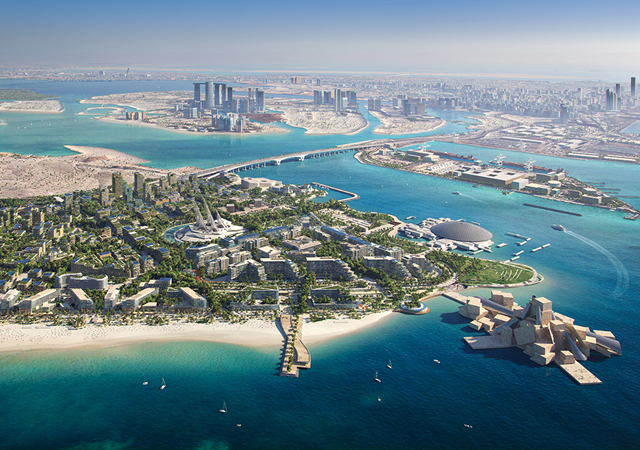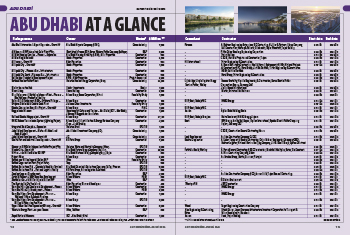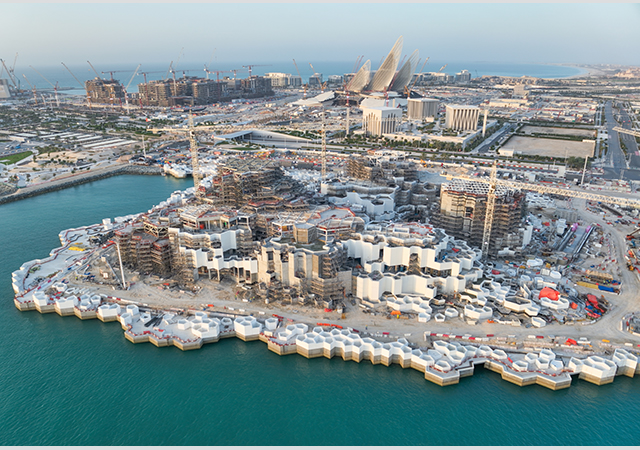
 Saadiyat Cultural District is a hive of construction activity with work in progress on a number of museums as well as residential buildings.
Saadiyat Cultural District is a hive of construction activity with work in progress on a number of museums as well as residential buildings.
Abu Dhabi’s construction sector is booming, fuelled by a combination of government investment, ambitious mega-projects, and a growing emphasis on sustainability. This translates to increasing opportunities for construction companies and a rapidly evolving cityscape.
The emirate’s construction sector showed a remarkable growth of 13.1 per cent in 2023 compared to 2022, with the added value of this sector reaching more than AED97 billion ($26.41 billion), the highest in 10 years. The sector contributed 8.5 per cent to the emirate’s gross domestic product during the same period, according to the Statistics Centre – Abu Dhabi (SCAD).
The real estate activities also grew 5.8 per cent during in 2023, compared to the previous year, the report added.
The projections are for the emirate’s construction sector to continue to show robust growth, thanks to the government’s continued focus on boosting infrastructure, social housing, developing power and water desalination capacity, especially through renewable sources.
In December last year, a budget of AED65 billion ($17.7 billion) was approved by the Crown Prince of Abu Dhabi and Chairman of the Abu Dhabi Executive Council Sheikh Khaled bin Mohamed bin Zayed Al Nahyan to cover 142 new capital projects in the emirate this year. This strategic investment prioritises infrastructure development and cultural heritage, ensuring a sustainable and cohesive living environment for the emirate’s residents.
In line with its focus on culture, several iconic museum projects – including Shaikh Zayed National Museum, Natural History Museum Abu Dhabi, Guggenheim Museum and teamLab Phenomena Abu Dhabi – are taking shape on Saadiyat Island’s Cultural District, which will host one of the greatest concentrations of cultural institutions on completion in 2025.
Following the opening of the Abrahamic Family House early last year, Abu Dhabi witnessed the inauguration of the BAPS Hindu Mandir – the first traditional stone Hindu temple in the entire Middle East – in Februrary this year. This architectural marvel stands as a testament to Abu Dhabi’s commitment to tolerance, religious diversity and cultural heritage.
This apart, Abu Dhabi has been making commendable progress on an international scale on the clean energy front. Its pioneering project, Barakah Nuclear Plant, has each of its four units linked to the transmission grid becoming the first nuclear power station in the Arabian Peninsula. The 5,600 MW plant can supply a quarter of the UAE’s electricity requirements. The emirate has now voiced its interest in building a second nuclear plant.
Further solidifying its position as a leader in clean energy, Abu Dhabi inaugurated the Al Dhafra Solar Photovoltaic (PV)project late last year. This record-breaking project holds the title of the world’s largest single-site solar power plant.
With massive solar energy projects like Al Dhafra Solar PV, and others such as Al Ajban Solar PV, and Khazna Solar PV on the horizon, the emirate is actively shaping a sustainable future.
In the water sector, the Taweelah desalination plant, the world’s largest reverse osmosis desalination plant, became operational in March this year. This engineering marvel not only provides clean drinking water for millions but also integrates solar energy, showcasing Abu Dhabi’s commitment to sustainable solutions. Another project, the Shuweihat 4 reverse osmosis (RO) desalination plant is prioritising low-carbon desalination methods.
Power & Water
The UAE, and specifically Abu Dhabi, has made remarkable strides in the renewables energy sector and today stands at the forefront of energy transition.
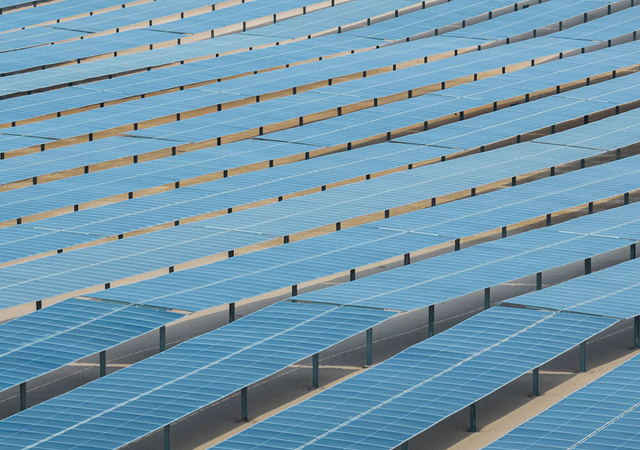 |
|
Al Dhafra Solar PV project ... the world’s largest single-site solar power plant. |
As the final reactor of the Arab world’s first nuclear plant at Barakah is set to start commercial operations this year, the UAE is considering building a second nuclear power plant to meet growing demand for electricity in the country, a government official told Reuters.
The government has yet to budget for a second power plant or decide on the size or the location, but Hamad Alkaabi, the UAE’s Ambassador to Austria and the Permanent Representative to the UN’s nuclear agency, said a tender could possibly be issued this year.
Any new power plant would likely consist of two or four reactors, said Alkaabi.
In the solar power sector, Abu Dhabi has recently seen the completion of the world’s largest single-site solar power plant at Al Dhafra and the emirate now has ambitions to set up two other plants of similar scale and production capacity at Al Khazna and Al Ajban.
The 2GW Al Dhafra Solar PV project was built in a single phase and generates enough electricity to power almost 200,000 homes, displacing 2.4 million tonnes of carbon emissions every year. It has been built over an area of more than 20 sq km of Abu Dhabi desert in Al Dhafra by a joint venture of Abu Dhabi-based Masdar with Abu Dhabi National Energy Company (Taqa), French group EDF Renewables and China’s JinkoPower.
It uses almost four million solar panels which deploy innovative bi-facial technology, ensuring sunlight is captured on both sides of the panels to maximise yield.
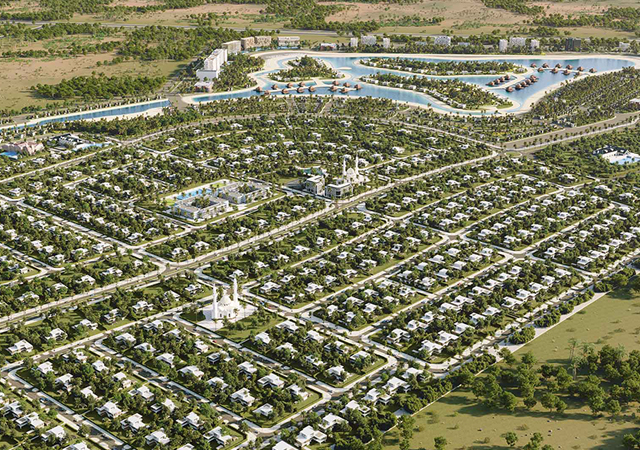 |
|
The AED22-billion Arabian Hills Estate ... infrastructure works have been awarded. |
The Emirates Water and Electricity Company (Ewec) has recently invited developers and developer consortiums to submit expressions of interest (EOI) for setting up the new solar PV Independent Power Project (IPP) in Al Khazna. The greenfield solar power project with a generation capacity of 1,500 MW (AC) will produce enough electricity to power approximately 160,000 homes across the UAE, and is expected to reduce CO2 emissions by more than 2.4 million tonnes per year.
The UAE also launched its 103.5 MW Wind Program in October, marking a new milestone in the country’s move towards clean energy. The project demonstrates for the first time the latest technology and innovation to capture low wind speeds at utility scale, adopting advances in material science and aerodynamics to make wind power possible in the country.
The UAE Wind Program is expected to power over 23,000 UAE homes. It will displace 120,000 tonnes of CO2 emissions.
The project spans four locations including the picturesque Sir Bani Yas Island, Abu Dhabi, which is home to free-roaming wildlife. A 45 MW capacity wind farm plus 14 MWp (megawatt peak) solar farm has been developed on the island. The other wind farm locations include the historical pearl-diving centre Delma Island (27 MW) in Abu Dhabi, Al Sila, Abu Dhabi (27 MW) and Al Halah, Fujairah (4.5 MW).
Meanwhile, Ewec is looking at setting up a new carbon-capture-ready combined-cycle gas turbine (CCGT) plant at Taweelah and last month issued a request for proposals (RFP) for its development (see UAE Focus, Page 57).
In the water sector, the Taweelah desalination plant began commercial operations early this year as the largest reverse osmosis desalination plant in the world. The plant has a production capacity of 909,218 cu m per day and guarantees water supply to the city of Abu Dhabi (approximately four-and-a-half million people) throughout the year. It is also the emirate’s first large-scale plant to combine the production of drinking water with the generation of clean energy, thanks to the installation of a photovoltaic solar field with a capacity of more than 70 MWp.
Construction is now in progress on the AED1.6 billion Shuweihat 4 RO seawater desalination project, which is expected to commence production in Q2 2026. Taqa and Spanish utility major GS Inima – which own 60 per cent and 40 per cent of the project – have signed an agreement with Ewec for the financial closing of the project.
Located within the Shuweihat Power and Water Complex, the low-carbon intensive Shuweihat 4 RO project will supply up to 70 million imperial gallons per day (MIGD) of potable water.
Another RO project on the anvil is the new Abu Dhabi Islands RO independent water project (IWP), which consists of two standalone greenfield low-carbon intensive RO seawater desalination plants to be located on Saadiyat Island and Hudayriat Island.
Together, the plants will provide a total of 100 MIGD, equivalent to 455,000 cu m potable water per day, said Ewec.
Housing
The government is prioritising the development of integrated and sustainable residential communities that cater to the needs of Emirati families. This is exemplified by the recently launched Balghaiylam project, which offers more than 1,700 ready-built homes. Public-private partnerships are playing a crucial role in making these housing developments affordable and accessible.
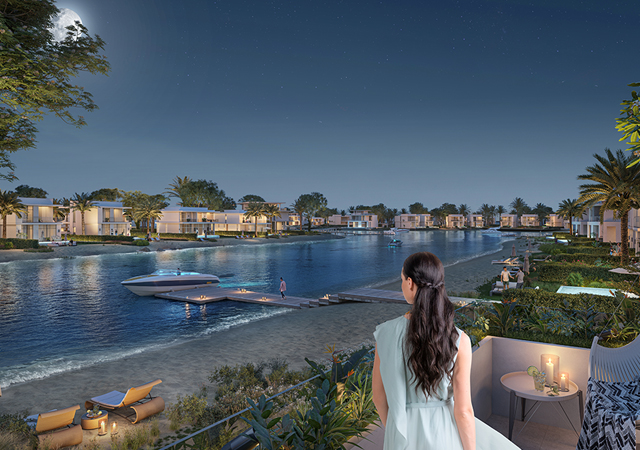 |
|
Ramhan Island by Eagle Hills ... spread over a 4 million sq m area off the coast of Abu Dhabi. |
The AED8 billion project, located north-east of Yas Island, will offer 1,743 ready-built homes and access to a broad range of facilities when it is completed in 2026.
In addition to housing, the Balghaiylam residential project will boast several key amenities including schools, mosques, retail and F&B outlets, sports centres, community gardens, and an equestrian centre, providing citizens with access to amenities in an integrated community.
Oil & Gas
Abu Dhabi is taking a pioneering role in reducing the carbon footprint of its oil and gas operations. The Ruwais LNG project, slated to be the first LNG export facility in the Middle East powered by clean energy, exemplifies this commitment.
The Adnoc facility, one of the lowest-carbon intensity LNG plants in the world, is currently under development in Al Ruwais Industrial City, Abu Dhabi and is expected to begin commercial operations in 2028.
NMDC Energy (formerly NPCC), in partnership with French group Technip Energies and Japan’s JGC Corporation, has secured a $5.5-billion contract from Adnoc to provide engineering, procurement and construction (EPC) services for the Ruwais LNG project.
The project consists of two 4.8 million metric tonnes per annum (mmtpa) natural gas liquefaction trains. This is set to more than double Adnoc’s LNG production capacity, from 6 mmtpa to around 15 mmtpa. The plant will use electric-driven motors instead of conventional gas turbines and will be powered by clean energy.
This focus on sustainability extends to expanding the natural gas pipeline network, providing cleaner fuel options for industries across the UAE. Adnoc Gas, a top-class integrated gas processing company, awarded contracts worth a total of $1.34 billion last year to Petrofac Emirates and a consortium of NMDC Energy and CAT International for the expansion of its natural gas pipeline network.
The new pipeline will extend Adnoc Gas’ existing pipeline network from 3,200 km to over 3,500 km, enabling the transportation of higher volumes of natural gas to customers in the Northern Emirates.
Industry
Sustainability is a major theme in Abu Dhabi’s industrial development. The construction of the first waste-to-energy (WtE) plant in the emirate reflects a commitment to responsible waste management and reducing greenhouse gas emissions.
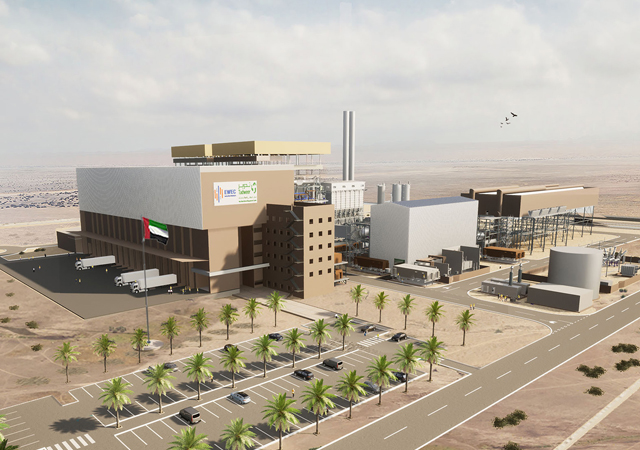 |
|
Abu Dhabi’s first WtE facility, situated near the Al Dhafra landfill, will process 900,000 tonnes of waste annually. |
The UAE-based Alec Engineering and Contracting in joint venture with Lebanese builder Butec has secured the design-and-build contract for the WtE plant. The Alec-Butec JV has teamed up with the Swiss-based Hitachi Zosen Innova (HZI), a company renowned for its expertise in WtE technology, to collaborate on the construction of this project.
According to Alec, the ultra-large waste incineration facility, situated near the Al Dhafra landfill, will process 900,000 tonnes of non-recyclable waste annually over the next 30 years. Furthermore, the plant will add 80MW of power generation capacity from a non-fossil fuel source, it stated.
In line with the energy transition, Schneider Electric, a global leader in the digital transformation of energy management and automation, has signed an agreement with Volts, a technology company within Masdar City, to set up a giga industrial facility for the production of battery energy storage systems (BESS) in Abu Dhabi.
This apart, Emirates Global Aluminium (EGA), the largest industrial company in the UAE outside oil and gas, has started work on its new aluminium recycling plant at Al Taweelah located in the Khalifa Industrial Zone Abu Dhabi (Kizad) – reinforcing the emirate’s shift towards a more circular economy that prioritises resource conservation.
The 170,000-tonne-per-annum facility is coming up next to EGA’s smelter and once completed in 2026, it will become the largest aluminium recycling plant in the UAE.
Real Estate
Abu Dhabi’s real estate market is catering to a diverse range of needs and preferences, with a focus on luxury living, sustainable design, and integrated communities.
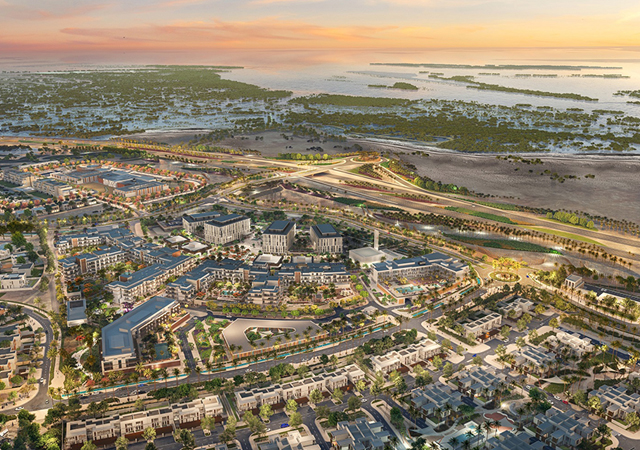 |
|
The AED15-billion Jubail Island project marked the completion of its first village, Nad Al Dhabi. |
Among the latest mega launches in the emirate is the AED22-billion Arabian Hills Estate, which offers freehold ownership in a gated community with stunning lagoons, natural pools, parks, equestrian facilities, and high-end amenities. The first phase is expected to be completed in Q1 2025.
A master-planned gated community, Arabian Hills Estate will come up over a 244-million-sq-ft area along the road connecting Dubai and Al Ain. This project is a strategic partnership between Arabian Hills Real Estate Development Company and Ara Real Estate Development, the real estate division of Core International Holdings Group. The developers have recently appointed National Transport and Contracting Company to undertake the infrastructure works on the project.
Another major development launched in May is a new luxurious sanctuary – Ramhan Island by Eagle Hills – spread over a 4 million sq m area off the coast of Abu Dhabi. Being developed by Eagle Hills, the masterplan of the project offers waterfront luxury villas with high-end amenities, a world-class marina, and a wellness centre. Ramhan Island by Eagle Hills will boast over 1,800 standalone villas, 900 marina residences, luxury brand residences, a luxury marina hotel and a vibrant retail promenade boasting 1.7 km of shopping delights.
Another key Abu Dhabi developer Aldar Properties has embarked on expanding the residential offering on Yas Island, its striking leisure and tourism island, which is home to developments such as Yas Marina Circuit, Yas Waterworld and Ferrari World. It has launched Sama Yas, the first collection of exquisite low-rise homes that embrace a holistic approach to well-being and offer luxury park living on Yas Island. Set against the serene backdrop of Yas Park, this boutique residential community features 234 elegant homes with parkland surrounds. Aldar said the development will aim to achieve the Estidama 3 Pearl rating, LEED Gold certification, and Fitwel certification for the masterplan and will incorporate sustainability measures into its design to reduce energy, water, and waste consumption.
Meanwhile, the AED15-billion Jubail Island project has been making significant progress over the past year and marked the completion of its first village Nad Al Dhabi, with the handover of 44 residential units. The large-scale development – spearheaded by Jubail Island Investment Company (JIIC) – has also seen the launch of a new AED4-billion community, Bada Al Jubail, which features luxurious mansions with a bespoke marina, yacht club, and waterfront living and is targeted for completion by 2027-end.
Also making impressive headway is Bloom Living, where leading UAE developer Bloom Holding has launched its latest community, Seville. The fifth phase of the fully integrated and all-inclusive community, Seville features premium residential units with lakefront views, ranging from mansions to townhouses. Inspired by Mediterranean architecture, the project prioritises indoor-outdoor living and is scheduled for completion in Q1 2027.
Conclusion
Looking ahead, Abu Dhabi’s construction sector shows no signs of slowing down. This focus on innovation and clean energy positions the emirate as a global leader in sustainable construction practices, attracting international investment and expertise. As Abu Dhabi continues to invest in infrastructure, cultural landmarks, and renewable energy, its construction industry is certain to play a pivotal role in its ongoing transformation.

















.jpg)













 (1).jpg)














































